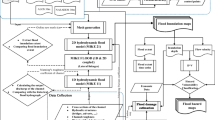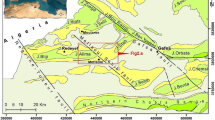Abstract
Shallow landslides are a common type of rainfall-induced landslide, and various methods are currently used to predict their occurrence on a regional scale. Physically based models, such as the shallow landslide instability prediction (SLIP) model, have many advantages because these models can assess the hazards of shallow landslides dynamically, based on physical stability equations that consider rainfall as a triggering factor. The main objective of this research is to test the SLIP model’s potential to predict shallow landslide hazards in Thailand. To achieve this goal, the SLIP model was applied to two massive landslide events in Thailand. The results predicted by the SLIP model for the two study areas are outlined, and the model prediction capabilities were evaluated using the receiver operating characteristic plot. The Phetchabun results showed that the western part of the catchment had the lowest factor of safety (F S) value, whereas the Krabi results showed that the slopes surrounding the peak of Khao Panom Mountain had the lowest F S value, explaining the highest potentials for shallow landslides in each area. The SLIP model showed good performance: The global accuracies were 0.828 for the Phetchabun area and 0.824 for the Krabi area. The SLIP model predicted the daily time-varying percentage of unstable areas over the analyzed periods. The SLIP model simulated a negligible percentage of unstable areas over all considered periods, except for expected dates, suggesting that the prediction capability is reasonably accurate.







Similar content being viewed by others
References
Arnone E, Noto LV, Lepore C, Bras RL (2011) Physically-based and distributed approach to analyze rainfall-triggered landslides at watershed scale. Geomorphology 133:121–131. doi:10.1016/j.geomorph.2011.03.019
Baum RL, Savage W, Godt J (2002) TRIGRS: a FORTRAN program for transient rainfall infiltration and grid-based regional slope-stability analysis. USGS. Colorado. Open-file Report 02-424
Baum RL, Coe JA, Godt JW et al (2005) Regional landslide-hazard assessment for Seattle, Washington, USA. Landslides 2:266–279. doi:10.1007/s10346-005-0023-y
Bednarik M, Yilmaz I, Marschalko M (2012) Landslide hazard and risk assessment: a case study from the Hlohovec–Sered’ landslide area in south-west Slovakia. Nat Hazards 64:547–575. doi:10.1007/s11069-012-0257-7
Beguería S (2006) Validation and evaluation of predictive models in hazard assessment and risk management. Nat Hazards 37:315–329. doi:10.1007/s11069-005-5182-6
Bui DT, Lofman O, Revhaug I, Dick O (2011) Landslide susceptibility analysis in the Hoa Binh province of Vietnam using statistical index and logistic regression. Nat Hazards 59:1413–1444. doi:10.1007/s11069-011-9844-2
Calcaterra D, Riso R, Di Martire D (2004) Assessing shallow de-bris slide hazard in the Agnano Plain (Naples, Italy) using SIN-MAP, a physically based slope-stability model. In: Lacerda et al (ed) Landslides: evaluation and stabilization. Taylor & Francis Group, Rio de Janeiro, pp 177–183
Casadei M, Dietrich WE, Miller NL (2003) Testing a model for predicting the timing and location of shallow landslide initiation in soil-mantled landscapes. Earth Surf Proc Land 28:925–950. doi:10.1002/esp.470
Catani F, Casagli N, Ermini L et al (2005) Landslide hazard and risk mapping at catchment scale in the Arno River basin. Landslides 2:329–342. doi:10.1007/s10346-005-0021-0
Cervi F, Berti M, Borgatti L et al (2010) Comparing predictive capability of statistical and deterministic methods for landslide susceptibility mapping: a case study in the northern Apennines (Reggio Emilia Province, Italy). Landslides 7:433–444. doi:10.1007/s10346-010-0207-y
Chiang S-H, Chang K-T (2009) Application of radar data to modeling rainfall-induced landslides. Geomorphology 103:299–309. doi:10.1016/j.geomorph.2008.06.012
Chiang S-H, Chang K-T (2011) The potential impact of climate change on typhoon-triggered landslides in Taiwan, 2010–2099. Geomorphology 133:143–151. doi:10.1016/j.geomorph.2010.12.028
Chung CF, Fabbri AG (1999) Probabilistic prediction models for landslide hazard mapping. Photogramm Eng Remote Sens 65:1389–1399
Collison A, Wade S, Griffiths J, Dehn M (2000) Modelling the impact of predicted climate change on landslide frequency and magnitude in SE England. Eng Geol 55:205–218. doi:10.1016/S0013-7952(99)00121-0
Crosta G (1998) Regionalization of rainfall thresholds: an aid to landslide hazard evaluation. Environ Geol 35:131–145. doi:10.1007/s002540050300
Devkota KC, Regmi AD, Pourghasemi HR et al (2012) Landslide susceptibility mapping using certainty factor, index of entropy and logistic regression models in GIS and their comparison at Mugling–Narayanghat road section in Nepal Himalaya. Nat Hazards 65:135–165. doi:10.1007/s11069-012-0347-6
Dhakal AS, Sidle RC (2003) Long-term modelling of landslides for different forest management practices. Earth Surf Proc Land 28:853–868. doi:10.1002/esp.499
Ewen J, Parkin G, O’Connell PE (2000) SHETRAN: distributed river basin flow and transport modeling system. J Hydrol Eng 5:250–258. doi:10.1061/(ASCE)1084-0699(2000)5:3(250
Friedl M, McIver D, Hodges JC et al (2002) Global land cover mapping from MODIS: algorithms and early results. Remote Sens Environ 83:287–302. doi:10.1016/S0034-4257(02)00078-0
Glenn NF, Streutker DR, Chadwick DJ et al (2006) Analysis of LiDAR-derived topographic information for characterizing and differentiating landslide morphology and activity. Geomorphology 73:131–148. doi:10.1016/j.geomorph.2005.07.006
Godt JW, Schulz WH, Baum RL et al (2008) Modeling rainfall conditions for shallow landsliding in Seattle, Washington. Rev Eng Geol 20:137–152. doi:10.1130/2008.4020(08
Guns M, Vanacker V (2012) Logistic regression applied to natural hazards: rare event logistic regression with replications. Nat Hazards Earth Syst Sci 12:1937–1947. doi:10.5194/nhess-12-1937-2012
Guzzetti F, Carrara A, Cardinali M, Reichenbach P (1999) Landslide hazard evaluation: a review of current techniques and their application in a multi-scale study, Central Italy. Geomorphology 31:181–216. doi:10.1016/S0169-555X(99)00078-1
Guzzetti F, Peruccacci S, Rossi M, Stark CP (2007) The rainfall intensity–duration control of shallow landslides and debris flows: an update. Landslides 5:3–17. doi:10.1007/s10346-007-0112-1
Hong Y, Adler RF (2007) Towards an early-warning system for global landslides triggered by rainfall and earthquake. Int J Remote Sens 28:3713–3719. doi:10.1080/01431160701311242
Hong Y, Adler R, Huffman G (2006) Evaluation of the potential of NASA multi-satellite precipitation analysis in global landslide hazard assessment. Geophys Res Lett 33:1–5. doi:10.1029/2006GL028010
Huffman GJ, Bolvin DT, Nelkin EJ et al (2007) The TRMM multisatellite precipitation analysis (TMPA): quasi-global, multiyear, combined-sensor precipitation estimates at fine scales. J Hydromet 8:38–55. doi:10.1175/JHM560.1
Iverson RM (2000) Landslide triggering by rain infiltration. Water Resour Res 36:1897. doi:10.1029/2000WR900090
Jakob M, Lambert S (2009) Climate change effects on landslides along the southwest coast of British Columbia. Geomorphology 107:275–284. doi:10.1016/j.geomorph.2008.12.009
Jotisankasa A (2008) Investigation of soil moisture characteristics of landslide-prone slopes in Thailand. In: Proceeding of 7th international conference on management of landslide hazard in the Asian-Pacific Region. Miyagi, pp 383–394
Kawagoe S, Kazama S, Sarukkalige PR (2010) Probabilistic modelling of rainfall induced landslide hazard assessment. Hydrol Earth Syst Sci 14:1047–1061. doi:10.5194/hess-14-1047-2010
Kirschbaum DB, Adler R, Hong Y et al (2009) A global landslide catalog for hazard applications: method, results, and limitations. Nat Hazards 52:561–575. doi:10.1007/s11069-009-9401-4
Liao Z, Hong Y, Wang J et al (2010) Prototyping an experimental early warning system for rainfall-induced landslides in Indonesia using satellite remote sensing and geospatial datasets. Landslides 7:317–324. doi:10.1007/s10346-010-0219-7
Liao Z, Hong Y, Kirschbaum D, Liu C (2011) Assessment of shallow landslides from Hurricane Mitch in central America using a physically based model. Environ Earth Sci. doi:10.1007/s12665-011-0997-9
Lin Y-P, Chu H-J, Wu C-F (2010) Spatial pattern analysis of landslide using landscape metrics and logistic regression: a case study in Central Taiwan. Hydrology Earth Syst Sci Discuss 7:3423–3451. doi:10.5194/hessd-7-3423-2010
Massonnet D, Feigl KL (1998) Radar interferometry and its application to changes in the Earth’s surface. Rev Geophys 36:441–500. doi:10.1029/97RG03139
Montgomery DR, Dietrich WE (1994) A physically based model for the topographic control on shallow landsliding. Water Resour Res 30:1153–1171. doi:10.1029/93WR02979
Montgomery DR, Sullivan K, Greenberg HM (1998) Regional test of a model for shallow landsliding. Hydrol Processes 12:943–955. doi:10.1002/(SICI)1099-1085(199805)12:6<943:AID-HYP664>3.0.CO;2-Z
Montrasio L, Valentino R (2008) A model for triggering mechanisms of shallow landslides. Nat Hazards Earth Syst Sci 8:1149–1159. doi:10.5194/nhess-8-1149-2008
Montrasio L, Valentino R, Quintavalla C (2010) Estimation of the degree of saturation of shallow soils from satellite observations to model soil slips occurred in Emilia Romagna Region of Northern Italy. Int J Geosci 1:58–65. doi:10.4236/ijg.2010.12008
Montrasio L, Valentino R, Losi GL (2011a) Towards a real-time susceptibility assessment of rainfall-induced shallow landslides on a regional scale. Nat Hazards Earth Syst Sci 11:1927–1947. doi:10.5194/nhess-11-1927-2011
Montrasio L, Valentino R, Losi GL (2011b) Shallow landslides triggered by rainfalls: modeling of some case histories in the Reggiano Apennine (Emilia Romagna Region, Northern Italy). Nat Hazards 60:1231–1254. doi:10.1007/s11069-011-9906-5
Morrisey MM, Wieczorek GF, Morgan BA (2001) A comparative analysis of hazard models for predicting debris flows in Madison County. Virginia. USGS. Open-File Report 01-0067
Nguyen HT, Wiatr T, Fernández-Steeger TM et al (2012) Landslide hazard and cascading effects following the extreme rainfall event on Madeira Island (February 2010). Nat Hazards 65:635–652. doi:10.1007/s11069-012-0387-y
Nichol J, Wong MS (2005) Satellite remote sensing for detailed landslide inventories using change detection and image fusion. Int J Remote Sens 26:1913–1926. doi:10.1080/01431160512331314047
O’Loughlin CL, Pearce AJ (1976) Influence of Cenozoic geology on mass movement and sediment yield response to forest removal, North Westland, New Zealand. Bull Int Assoc Eng Geol 13:41–46. doi:10.1007/BF02634757
Oh H-J, Lee S, Chotikasathien W et al (2008) Predictive landslide susceptibility mapping using spatial information in the Pechabun area of Thailand. Environ Geol 57:641–651. doi:10.1007/s00254-008-1342-9
Pachauri AK, Pant M (1992) Landslide hazard mapping based on geological attributes. Eng Geol 32:81–100. doi:10.1016/0013-7952(92)90020-Y
Pack RT, Tarboton DG, Goodwin CN (1998) Terrain stability mapping with SINMAP, Technical description and users guide for version 1.00. http://www.engineering.usu.edu/dtarb/. Accessed 3 June 2008
Pack RT, Tarboton DG, Goodwin CN (2001) Assessing terrain stability in a GIS using SINMAP. In: Proceeding of 15th annual GIS conference, GIS 2001. Vancouver, pp 56–68
Pradhan B (2010) Remote sensing and GIS-based landslide hazard analysis and cross-validation using multivariate logistic regression model on three test areas in Malaysia. Adv Space Res 45:1244–1256. doi:10.1016/j.asr.2010.01.006
Pradhan B, Mansor S, Pirasteh S, Buchroithner MF (2011) Landslide hazard and risk analyses at a landslide prone catchment area using statistical based geospatial model. Int J Remote Sens 32:4075–4087. doi:10.1080/01431161.2010.484433
Soralump S (2010) Rainfall-triggered landslide: from research to mitigation practice in Thailand. Geotech Eng J SEAGS&AGSSEA 41:1–6
Soralump S (2011) 2011 Disastrous Landslides at Khao Panom, Krabi, Thailand. In: Proceeding of EIT-Japan symposium 2011 on human security engineering. Bangkok, pp 29–31
Tanavud C (2008) Management of landslide hazard in Thailand. In: Proceeding of 7th international conference on management of landslide hazard in the Asian-Pacific Region. Miyagi, pp 109–123
Tarolli P, Borga M, Chang K-T, Chiang S-H (2011) Modeling shallow landsliding susceptibility by incorporating heavy rainfall statistical properties. Geomorphology 133:199–211. doi:10.1016/j.geomorph.2011.02.033
Vieira BC, Fernandes NF, Filho OA (2010) Shallow landslide prediction in the Serra do Mar, São Paulo, Brazil. Nat Hazards Earth Syst Sci 10:1829–1837. doi:10.5194/nhess-10-1829-2010
Wang HB, Wu SR, Shi JS, Li B (2011) Qualitative hazard and risk assessment of landslides: a practical framework for a case study in China. Nat Hazards. doi:10.1007/s11069-011-0008-1
Wu W, Sidle RC (1995) A distributed slope stability model for steep forested basins. Water Resour Res 31:2097–2110. doi:10.1029/95WR01136
Wu TH, McKinnell WP III, Swanston DN (1979) Strength of tree roots and landslides on Prince of Wales Island, Alaska. Can Geotech J 16:19–33. doi:10.1139/t79-003
Yumuang S (2006) 2001 debris flow and debris flood in Nam Ko area, Phetchabun province, central Thailand. Environ Geol 51:545–564. doi:10.1007/s00254-006-0351-9
Acknowledgments
This research was supported by the Environment Research and Technology Development Fund (S-8) of the Ministry of the Environment, Japan. This research was conducted by the IMPAC-T project supported by JST/JICA, SATREPS, Japan. We wish to thank Dr. Suttisak Soralump at Kasetsert University in Thailand for his helpful support. Part of this research was supported by a Grant-in-Aid for JSPS (Japan Society for the Promotion of Science) Fellows.
Author information
Authors and Affiliations
Corresponding author
Rights and permissions
About this article
Cite this article
Ono, K., Kazama, S. & Ekkawatpanit, C. Assessment of rainfall-induced shallow landslides in Phetchabun and Krabi provinces, Thailand. Nat Hazards 74, 2089–2107 (2014). https://doi.org/10.1007/s11069-014-1292-3
Received:
Accepted:
Published:
Issue Date:
DOI: https://doi.org/10.1007/s11069-014-1292-3




